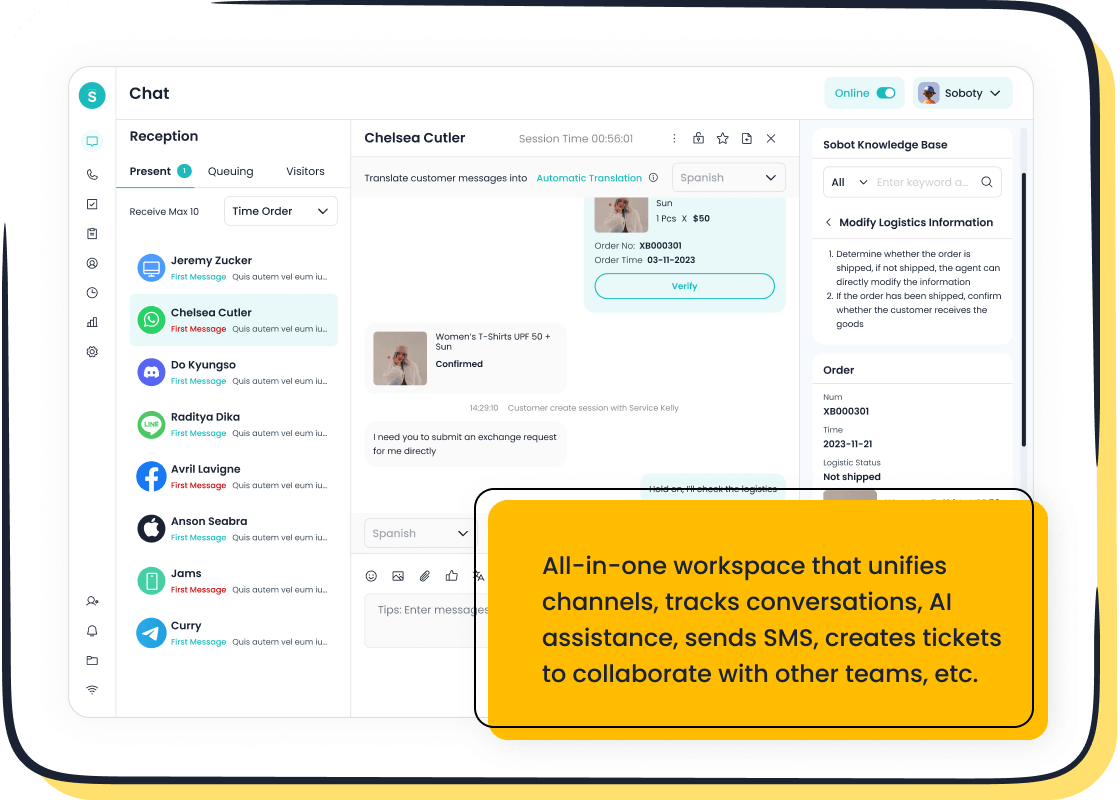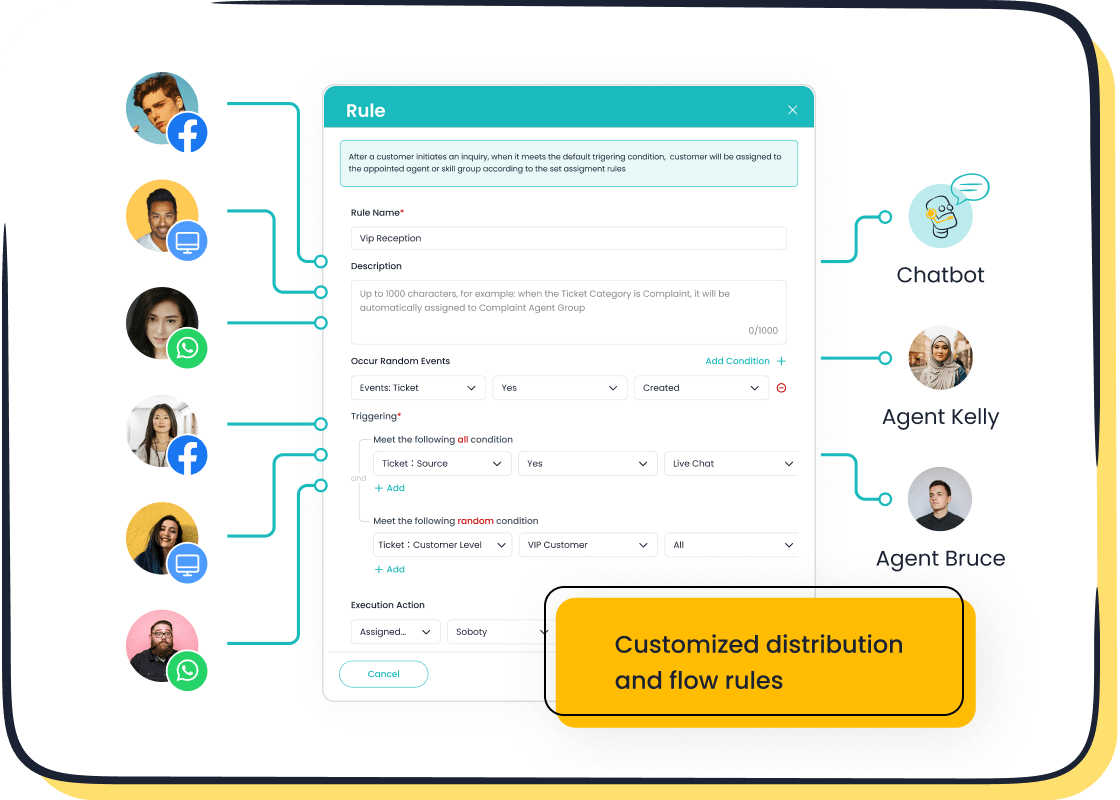Master Customer Service and Management Skills with These Tips

Mastering customer service and management skills is essential for thriving in today’s competitive market. Did you know that happier employees can boost earnings by 147%? Plus, 91% of customers are more likely to return after a positive experience. By focusing on these skills, especially with the support of Sobot, you’ll enhance satisfaction, efficiency, and loyalty—key drivers of success.
Why Customer Service and Management Skills Are Essential
The role of customer service in business growth
Customer service is the backbone of any thriving business. When you deliver excellent customer service, you’re not just solving problems—you’re building trust and loyalty. Did you know that customers who feel valued spend 140% more than those who don’t? That’s a huge opportunity for growth. Plus, acquiring new customers costs 5-7 times more than keeping existing ones. By focusing on good customer service, you can reduce churn and boost retention.
Think about this: 58% of customers stop engaging with a brand after just one bad experience. On the flip side, businesses that personalize interactions see a 70% jump in customer satisfaction. Meeting customer expectations isn’t just a nice-to-have—it’s a must for staying competitive. Whether you’re a small business or a global enterprise, a strong customer service strategy can set you apart.
How management skills drive team success
Great management isn’t just about delegating tasks. It’s about inspiring your team to perform at their best. When you set clear goals and foster open communication, your team feels empowered. This leads to better collaboration and higher productivity. Strong management skills also help you identify and address customer needs more effectively, ensuring your team delivers consistent results.
For example, companies with engaged employees see a 10% boost in customer ratings. Why? Because motivated teams are more likely to go the extra mile. By investing in your management approach, you’re not just improving internal operations—you’re enhancing the overall customer experience.
The link between customer satisfaction and employee engagement
There’s a direct connection between happy employees and happy customers. Engaged employees create positive interactions, which directly impact customer satisfaction. According to Gallup, businesses with high employee engagement achieve a 20% increase in customer satisfaction scores. This ripple effect is hard to ignore.
| Source | Evidence |
|---|---|
| Qualtrics XM | Engaged employees lead to a 20% increase in customer satisfaction scores. |
| Gallup | High employee engagement boosts customer ratings by 10%. |
| Assembly | Employee attitudes directly influence customer experiences. |
| Springer | Employee engagement positively impacts customer retention. |
When your team feels valued, they’re more likely to meet and exceed customer expectations. This creates a cycle of satisfaction and loyalty that benefits everyone.
Key Strategies to Improve Customer Service and Management Skills

Practicing empathy and active listening
Empathy and active listening are game-changers when it comes to customer service. When you truly understand customer needs, you can provide solutions that feel personal and meaningful. Listening carefully to what your customers say—and even what they don’t say—helps build trust and loyalty. For example, metrics like Net Promoter Score (NPS) and Customer Satisfaction Score (CSAT) often improve when agents practice active listening. These scores reflect how well you connect with your customers during interactions.
Here’s a tip: Treat every complaint as an opportunity to show empathy. Instead of taking it personally, view it as a chance to solve a problem and strengthen the relationship. This mindset not only improves customer satisfaction but also boosts retention. Remember, customers who feel heard are more likely to stay loyal.
Setting clear goals and expectations
Clear goals and expectations are the foundation of effective management. When your team knows exactly what’s expected of them, they can focus on delivering results. Data shows that organizations using performance management practices are 23 times more likely to achieve strong business outcomes. That’s a compelling reason to prioritize clarity.
Start by setting measurable objectives for your team. For instance, you might aim to reduce response times or increase first-contact resolution rates. Share these goals openly and provide regular feedback. This approach not only improves team performance but also enhances customer service by ensuring consistency and accountability.
Encouraging a problem-solving mindset
A problem-solving mindset empowers your team to tackle challenges head-on. When your staff feels confident in their ability to resolve issues, they deliver better results. For example, focusing on reducing ticket resolution time by 25% or increasing satisfaction with the resolution process by 30% can lead to noticeable improvement in service quality.
Encourage your team to view every challenge as an opportunity to deliver value. Equip them with the tools and training they need to succeed. By fostering this mindset, you’ll not only enhance customer service but also create a culture of continuous improvement.
Actionable Tips to Improve Customer Service Communication
Using positive language to build trust
Positive language is a powerful tool in customer service communication. It helps you build trust and create a good customer service experience. Instead of focusing on what you can’t do, emphasize what you can do. For example, instead of saying, “We don’t have that product in stock,” try, “That product will be available next week, and I’d be happy to notify you when it arrives.” This small shift makes a big difference in how customers perceive your service.
Using positive language also helps diffuse tense situations. When customers feel heard and valued, they’re more likely to stay loyal. Remember, 72% of customers share positive experiences with others, which can boost your brand’s reputation. By focusing on solutions and maintaining a friendly tone, you can turn even challenging interactions into opportunities to enhance customer satisfaction.
Active listening for better understanding
Active listening is essential for understanding customer needs and delivering excellent customer service. It’s not just about hearing words—it’s about truly understanding the problem. Top sales performers, for instance, maintain a talk-to-listen ratio of 43:57. They prioritize listening over talking, which helps them understand customer concerns and offer tailored solutions.
When you practice active listening, you show customers that their opinions matter. This builds trust and improves communication. Simple actions like paraphrasing their concerns or asking clarifying questions can make a huge impact. Customers appreciate when you take the time to understand their needs, and this effort often leads to higher satisfaction scores like CSAT and NPS.
Handling challenging customers with professionalism
Dealing with challenging customers can be tough, but professionalism is key to enhancing customer service. When conflicts arise, stay calm and focus on resolving the issue. Customers are more forgiving when problems are handled respectfully and efficiently. In fact, resolving conflicts well can prevent larger issues and even improve your brand’s reputation.
Keep in mind that only 1 in 26 unhappy customers actually complain. The rest may silently leave, which is why every interaction counts. Responding with empathy and offering clear solutions can turn a negative experience into a positive one. This approach not only improves customer retention but also encourages customers to share their positive experiences with others.
Building a Culture of Good Customer Service
Fostering collaboration and open communication
Creating a culture of good customer service starts with fostering collaboration and open communication. When your team works together seamlessly, they can deliver better results for your customers. Open communication ensures that everyone feels heard and valued, which boosts morale and productivity. Did you know companies with effective communication strategies see a 21% increase in profitability? That’s a clear sign of how important it is to keep communication flowing.
Encourage your team to share ideas and feedback regularly. This could be through team meetings, suggestion boxes, or even casual check-ins. When employees feel comfortable voicing their thoughts, they’re more likely to come up with creative solutions to improve customer service. Plus, engaged employees often lead to higher customer satisfaction and loyalty. It’s a win-win for everyone.
Recognizing and rewarding customer-focused behavior
Recognition is a powerful motivator. When you reward employees for delivering good customer service, you inspire them to keep up the great work. Peer recognition, for example, can strengthen team relationships and build trust. In fact, 41% of companies using peer-to-peer recognition report improved customer satisfaction. A national retail chain even saw a 20% increase in customer satisfaction scores after introducing monthly recognition events.
You don’t need to go overboard with rewards. Simple gestures like a “thank you” email, a shoutout during a meeting, or an “Employee of the Month” award can make a big difference. These small acts show your team that their efforts matter, which boosts motivation and productivity. Recognized employees are more likely to go above and beyond, creating memorable experiences for your customers.
Providing continuous training and development
Customer service training is essential for building a team that consistently delivers excellent results. When you invest in training staff, you’re not just improving their skills—you’re also showing them that they’re valued. Employees at companies that prioritize learning resources are 83% more likely to feel satisfied with their jobs. This satisfaction translates directly into better customer interactions.
Offer regular workshops, online courses, or mentorship programs to help your team grow. Focus on areas like effective communication, problem-solving, and empathy. Remember, 80% of customers believe their experience with a company is as important as its products. By equipping your team with the right tools and knowledge, you’ll improve customer service and build lasting customer loyalty.

Leveraging Tools Like Sobot Live Chat to Enhance Customer Service
Benefits of using Sobot Live Chat for omnichannel support
Sobot Live Chat makes customer service seamless by offering omnichannel support. This means you can connect with your customers across platforms like WhatsApp, Facebook, and Instagram—all from one place. It ensures a consistent experience, no matter where your customers reach out. With AI-powered features and natural language processing (NLP), Sobot Live Chat understands customer queries better, speeding up response times and improving satisfaction.
Here’s a quick look at what Sobot Live Chat offers:
| Feature/Benefit | Description |
|---|---|
| AI-Powered Features | Enhances customer engagement and streamlines support processes. |
| Natural Language Processing | Accurately interprets customer queries, improving routing and response times. |
| Knowledge Base Management | Empowers customers to find solutions independently, reducing team workload. |
| Omnichannel Support | Provides consistent experiences across email, chat, social media, and voice. |
| Analytics and Reporting | Offers insights into customer behavior and support performance. |
These features not only simplify your operations but also help you deliver faster, more personalized service. That’s a win for both you and your customers.
Automating repetitive tasks to save time
Repetitive tasks can drain your team’s energy and slow down customer service. Sobot Live Chat solves this by automating routine processes like answering FAQs or routing tickets. This frees up your agents to focus on more complex issues that require a human touch. For example, OPPO, a global smartphone brand, used Sobot’s chatbot to handle repetitive queries, achieving an 83% resolution rate and a 94% positive feedback score.
Automation doesn’t just save time—it also improves efficiency. By reducing inbound discussions by 20%, Sobot Live Chat allows your team to handle more inquiries without feeling overwhelmed. This means faster responses and happier customers.
Using analytics to measure and improve service quality
Analytics is a game-changer when it comes to improving customer service. Sobot Live Chat provides real-time insights into customer interactions, helping you identify what’s working and what’s not. You can monitor case statuses, track response times, and even measure satisfaction levels. This visibility keeps your team accountable and ensures no issue slips through the cracks.
Here’s how analytics can make a difference:
- Real-time monitoring improves team accountability.
- Streamlined workflows save time and enhance communication.
- Average resolution times drop, boosting customer satisfaction.
By using these insights, you can continuously refine your strategies and deliver top-notch customer support. Sobot Live Chat makes it easy to turn data into action, ensuring your customers always receive the best service possible.
Mastering customer service and management skills is your ticket to happier customers and a more efficient team. These skills help you build trust, solve problems faster, and create lasting loyalty. By using tools like Sobot Live Chat and focusing on strategies like empathy and active listening, you’ll see real results.
Here’s a quick look at why these skills matter:
| KPI | Description | Benchmark/Importance |
|---|---|---|
| First Contact Resolution Rate | Percentage of queries resolved in the first interaction | Over 80% is considered good |
| Customer Satisfaction (CSAT) | Metric for customer happiness with the support experience | Higher scores indicate better service |
| Resolution Time | Time taken to close a support ticket | Shorter times indicate efficiency |
Take action today. Start small—set clear goals, reward great service, and invest in training. You’ll create a customer-focused environment that drives success.
FAQ
What is the best way to improve customer service skills?
Focus on active listening and empathy. Understand your customer's needs and provide personalized solutions. Practice regularly to build confidence and improve communication.
💡 Tip: Use tools like Sobot Live Chat to streamline interactions and enhance your service quality.
How can I handle a difficult customer effectively?
Stay calm and listen carefully. Acknowledge their concerns and offer clear solutions. Your professionalism can turn a negative experience into a positive one.
Why is customer feedback important?
Feedback helps you identify areas for improvement and understand what your customers value most. It’s a key driver for enhancing customer satisfaction and loyalty.
See Also
Essential Strategies for Effective Call Center Quality Control
Ten Strategies to Enhance Customer Satisfaction via Live Chat
Comprehensive Overview of Quality Management Systems in Call Centers